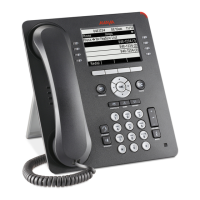• Use the ADDR option to verify IP addresses. For more information, see Changing IP
address information on page 44.
3. If the deskphone is not communicating with the system, DHCP, HTTP, or Avaya Media
Server, make a note of the last message displayed. For more information, see
Installation
error and status messages on page 74 and Operational errors and status messages on
page 78.
Consult the system administrator. Sometimes, you can correct problems relating to
Communication Manager and HTTP communications by setting the HTTPPORT value to
81.
4. If you want the deskphone to be IEEE-powered, verify with the LAN administrator that
IEEE power is indeed supported on the LAN.
Related links
Troubleshooting on page 69
Failure to hear DTMF tones
As H.323 telephones do not send DTMF tones to non-H.323 telephones, the user need not
perform troubleshooting for failure to hear DTMF tones from a 9600 Series IP phone. The
TN2302AP board does not pass in-band DTMF tones.
Related links
Troubleshooting on page 69
Correcting a power interruption
If power to a 9600 Series IP deskphone is interrupted while the phone is saving the application
file, the HTTP/HTTPS application can stop responding. If this occurs, restart the phone.
Related links
Troubleshooting on page 69
Using the VIEW procedure for troubleshooting
About this task
Use the following procedure to verify the current values of system parameters and file versions.
Note:
If administered through OPSTAT, end users can gain access to the Network Information option
from the Phone Settings option of Avaya Menu to view but not change most of the parameters
associated with Craft Local Procedures. For more information about this option, see the
applicable user guides.
Troubleshooting
March 2018 Installing and Maintaining Avaya 9608/9608G/9611G/9621G/9641G/9641GS IP
Deskphones H.323 70
Comments on this document? infodev@avaya.com

